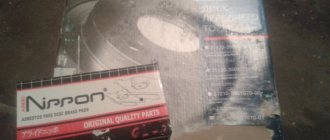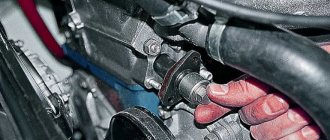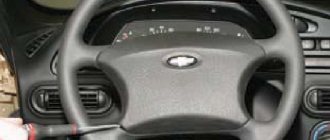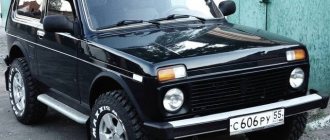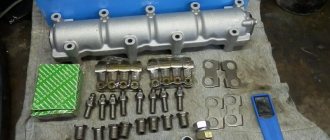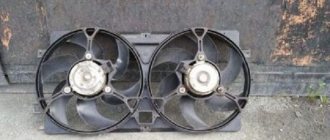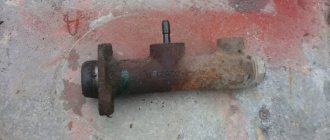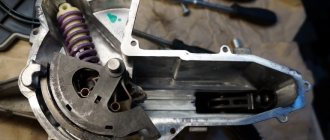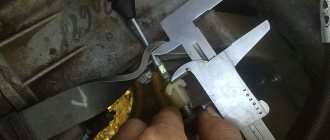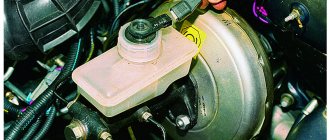Chevrolet Niva › Logbook › Replacing the Clutch Slave Cylinder.
Well, my patience has run out.
For 2 months it was leaking from under the car, namely from the working cylinder. Sometimes it got to the point where you would come in the morning and the pedal would already be empty. I forgot to top up the brake fluid in the evening, but it all ran away. Of course, I have a bonus that there is almost unlimited quantity of brake fluid. Top it up and let’s pump the pedal, 15-20 minutes are wasted. I endured and endured, and I went to the nearest one, Bal*K**, luckily it was nearby. It turned out that this spare part is present, 950 rubles. The manufacturer is really strange, “KAC”, let’s see how it behaves.
Having reached the garage, it turned out that we needed to sort out a little of the accumulated “junk”. Having dived into the hole, I found out that there was no dripping here, but simply flowing like from a tap,
Plus the barrel itself is cracked and needs to be replaced. It came, as they say, in one wave. To begin with, so as not to suffer later, unscrew the brake fluid supply hose to the working cylinder (17th key) and then you can safely unscrew the two bolts securing the bracket (13th key). Do not lose the plate that is under the cylinder; it presses the cylinder to the bracket and is located between the bracket and the gearbox housing, with the convex part outward. After you’ve collected everything that spilled out on you, you can safely unscrew the cylinder itself from the hose (be careful there’s a copper washer there, I don’t remember the size, but it’s better to replace it). Hurray, a stream of brake fluid started flowing at me, let it flow out, it’s not scary, but it’s realistic to get into trouble trying to fit a new cylinder. And so, nothing drips on me, I can collect it. Screwing on a new cylinder is not difficult; the difficulty arises when installing the rod. The thing is, my car doesn’t have a stabilizer (for religious reasons), which means I have nothing to rest the mounting on to pull the fork back. Fortunately, there was a bolt of the front lower silent blocks lying nearby, so I fixed it.
In your case, everything will be easier; you will have a stabilizer that you can rest against (Don’t forget to coat the rod with grease). Hurray, the rod is in place, tighten the hose, unscrew the bleeder fitting and climb out of the hole.
The turn has reached the barrel, there are no difficulties at all, 2 nuts for 10 and a clamp for 7, ready. I fill up the brake fluid and wait, since the classic pumping method alone will not work for me, so I go with my own method. The fact is that the hydraulic line is not large and is located almost vertically. Thus, you can bleed the system alone, by gravity, to squeeze out the air. We wait about one barrel for leakage, close the fitting and you're done, let's go check. Hooray! works)
P.S. For repairs using tools you need: 8 key 13 key 17 key Installation.
Source
Replacement
To change the cylinder you will need brake fluid, a wrench with a 13 socket head, and a 17 wrench. Operating procedure:
- Using a 13mm wrench, unscrew the bolts securing the control center to the clutch housing.
- Disconnect the spring, bracket and the working cylinder itself from the machine.
- Remove the fork pusher.
- Remove the protective cover.
- Using a 17 key, unscrew the hydraulic drive hose.
Installation of the RCS is carried out in the reverse order of removal. After installing a new or restored RCS, it is necessary to
Important: if only one boot is damaged, it is enough to replace only it without disconnecting the hose. Part number – 2123-1602518. The boot costs from 45 rubles, but it is better to buy high-quality spare parts at a price of 140 rubles and above.
Chevrolet Niva GOLDEN_FLY › Logbook › Replacing the rcs
12/13/2020 200055 km - 16372 rubles
Got around to replacing the clutch slave cylinder
I wanted the best...it turned out better than I wanted
Knowing that the rcs was leaking and having experience in restoring the cc and cc by replacing the repair kit, I bought it
And crawled under the car on the courts
I cleaned the cylinder of dirt and started removing
I wanted to unscrew the cylinder from the hose and fix it somewhere more comfortable and warm, but nothing came of it at all.
Then I decided to do everything in a canopy
My first thought was to buy the same one (I think they are on sale) and continue what I started, but something prompted me to buy a new control center and replace it in the assembly
I don’t trust Phoenix more than Samara, so I took the lower option
Due to the missing pressure plate, I also had to take a bracket
It was already sunset and before it got dark I still couldn’t unscrew the rcs from the hose (or vice versa)
But the morning is wiser than the evening...the idea came to unscrew the hose higher up from the tube and remove it from the bracket. Not an option at all - you can’t get it in / you can’t unscrew it.
Then the idea came to unscrew the entire line from the main central station, but there was no less trouble there...
Having suffered quite a bit on the courts at minus fifteen with the hose, having pretty much licked the edges, it was decided to remove the piston from the RCS and replace it with a new one from the box, along with the rod and boot of course.
This is where things started...
While I was walking to the trunk, I returned under the car and saw a puddle of brake fluid and an almost empty barrel (cellophane was nothing).
I inserted a new piston into the RCS, installed a retaining ring, and filled the barrel with brake fluid in full (my dad had a jar in his garage)
I loaded the pusher corrugation and attached the rcs to the gearbox on a bracket.
I pumped it by gravity. The pedal is where it was. The speeds are inserted smoothly without any problems.
There is a repair kit and a new case left in the NZ, maybe I’ll buy a bracket and assemble the RCS in my spare time as a reserve.
I noticed that Gur's hoses don't have much time left.
Most likely I’ll contact the service center... I got the screws screwed up with the RCS))
Niva Chevrolet and clutch slave cylinder: diagnostics, repair and replacement
The presence of a clutch in cars is not accidental, and its absence makes it impossible to travel in a vehicle. For most novice drivers, the clutch is the leftmost pedal in the car. But few people know its design, and therefore in this article we will pay attention to one of the main elements of the clutch - the working cylinder on a Chevrolet Niva. What is this product, why is it needed, where is it installed and how is it repaired and replacement parts carried out? You can learn about everything from this material.
Clutch cylinder on Niva Chevrolet
Every modern car has a control system with impact mechanisms. An integral part of every car with a manual transmission is the clutch, thanks to which there is a short-term interruption of the interaction between the transmission and the engine. The transmission of impulse from the driver to this mechanism occurs due to a hydraulic drive, in which one of the important parts is the Chevrolet Niva clutch master cylinder.
Purpose and design features of the working cylinder
There are two types of cylinders in the clutch mechanism: working and main. You can learn about the purpose of the main one from the corresponding article, and today we’ll look at the Chevrolet Niva clutch slave cylinder. The Chevrolet Niva clutch system is based on the operation of a hydraulic drive, which, in turn, is inoperative without a cylinder. The essence of its operation is to directly receive the force coming from the main cylinder and thereby move the clutch release fork.
The design of the working cylinder is absolutely identical for almost all car models, therefore the principle of operation of the device is the same. The product consists, first of all, of a base, that is, a body where the following parts are assembled in a certain order:
All parts are assembled in a certain sequence, which allows the device to function correctly.
The photo below shows the working cylinder of a Niva Chevrolet.
How does the device function?
To understand the issue of purpose in more detail, let’s consider how the product’s workflow is carried out. So, when you press the main control lever (i.e. the clutch pedal), the pusher moves, which acts on the piston and it moves forward. When the piston moves under the influence of mechanical force, the pressure in the housing begins to increase. This is a process that occurs in the clutch master cylinder. After increasing the pressure, the liquid begins to be squeezed out through the discharge channel and enters the working cylinder. It contains a piston with a fork, which, under the influence of pressure, squeezes out the release bearing, thereby separating the engine and gearbox. At this moment, the corresponding gear is engaged, and then the driver releases the clutch pedal. After releasing the pedal, a return to its original position is observed: the engine engages with the transmission, which is due to the action of the pushing spring in the cylinder.
This is the essence of the functioning of the working cylinder of a Chevrolet Niva SUV. You cannot do without breakdowns and malfunctions, which are inherent in any mechanism. Thus, it is periodically necessary to repair the cylinder, since its functioning is based on friction, and, therefore, wear.
Where can I find the clutch slave cylinder in my car? On the Chevrolet Niva SUV, this product is located on the clutch housing, as on almost all cars. To do this, you need to open the hood and look at the area under the hood on the driver's side.
Fault Diagnosis
Initially, it is important to make sure that this particular element is faulty and requires replacement or repair. To do this, there are ways to identify malfunctions that will allow the car owner not to resort to the help of auto repairmen. So, if you notice the following shortcomings:
Clutch cylinder in need of repair
In this case, you should pay special attention to the working cylinder and promptly carry out repairs to avoid further troubles.
Cylinder replacement and repair
Replacement is carried out in the event of irreparable defects, which include damage to the cylinder body. In all other cases, repairs will be required. But first, let's look at how to remove the slave cylinder from a Niva Chevrolet SUV and install a new repair kit.
What is clutch?
This is the unit through which torque from the engine is transmitted to the gearbox.
When the clutch does not work at the proper level, it will not only make it difficult to engage a particular gear, but will also negatively affect the operation of the engine and gearbox itself.
Clutch Niva Chevrolet VALEO.
On the Niva Chevrolet the clutch drive is hydraulic . And it also has automatic compensation for lining wear. The clutch drive is also of great importance, since it is with its help that the driver can control the clutch.
Video about how the clutch works
Chevrolet Niva the older the better › Logbook › Replacing RCS 2123 (clutch slave cylinder)
While driving, I pressed the clutch several times. Moreover, very sharply (the car jumped out into the meeting) - and the clutch “does not release.” The cylinder is jammed. I crawl under the car. Exactly - the working cylinder is squeezed out and does not crawl back.
I hammered it back in the direction of the red arrow. It’s good that our car is tall - you can crawl under it. The clutch worked. But a clear sign “it’s time to change” was already given.
2123-1602510 Working cylinder 900 rubles 2101-1601211 Clutch release fork cover 50 rubles 2123-1602492 Bracket VAZ-2123 clutch working cylinder 100 rubles
21230-1602494 Thrust plate aka 21230-1602157 RCS plate 30 rubles
21010-1602596 Copper washer d 12 mm 15 rubles Bolt M8x50 1.25 - 2 pcs Spring washer 8 - 2 pcs
This is how the hydraulic clutch works
Opening the tank lid
Unscrew the fluid hose from the cylinder and the cylinder itself.
(the plate was installed incorrectly - it is useless from the outside of the bracket - it should press the cylinder from the inside!)
At the same time, remove the torn cover and install a new one:
Compare old and new:
Installing a new cylinder
We put on a tube and “pump” it by gravity. (do not press the pedal!)
But the reason for the cylinder jamming is plaque and rust in the part where the cylinder rarely moves. Even with the ring removed, the piston did not come out.
Pull clutch working cylinder disassembled:
Features of the Chevrolet Niva clutch design
Clutch assembly: 1 — clutch housing; 2 - flywheel; 3 — bolt securing the clutch housing to the flywheel; 4 — driven disk; 5 — pressure disk; 6 — clutch casing; 7 — clutch release; 8 — gearbox input shaft; 9 — clutch release fork; 10 - central pressure spring.
The vehicle has a single-disc, dry, permanently closed clutch with a central diaphragm spring.
Clutch release drive: 1 — tube; 2 - main cylinder; 3 — master cylinder fastening nut; 4 — pedal bracket; 5 — clutch release; 6 — ball joint; 7 — clutch release fork; 8 — clutch release fork cover; 9 — bracket fastening bolt; 10 — bracket; 11 - working cylinder; 12 — valve for removing air; 13 — clutch pedal axis; 14 — clutch pedal; 15 — locking bracket; 16 — master cylinder pusher; 17 — bushing; 18 — locking bracket; 19 — bushing.
The clutch drive is hydraulic, backlash-free, with automatic compensation for wear of the friction linings of the driven disc. The drive consists of 2 main and 11 working cylinders, a clutch pedal, a hydraulic clutch release tube 1 and a hose.
Useful tips: To ensure a long and trouble-free clutch service, do not constantly keep your foot on the clutch pedal. This bad habit is often acquired while learning to drive in driving schools for fear of not having time to disengage the clutch while stopping the car. In addition to the rapid fatigue of the leg, which is always above the pedal, the clutch is depressed at least a little, and the driven disk slips and wears out. In addition, although the release bearing is designed to operate in constant rotation mode, when the pedal is pressed slightly, it is under increased load, and its service life is reduced.
For the same reason, we do not recommend keeping the clutch disengaged for a long time (for example, in traffic jams). If you don’t have to move away right away, it’s better to put the gearbox in neutral and release the pedal.
Clutch slipping can be easily determined using a tachometer. If while driving, when you sharply press the accelerator pedal, the speed rises sharply, and then drops a little and the car begins to accelerate, the clutch requires repair.
Clutch and its hydraulic drive: 1 — clutch release fork; 2 — bracket; 3 — working cylinder of the hydraulic clutch; 4 — fitting for bleeding; 5 — central diaphragm pressure spring; 6 — pressure disk; 7 - flywheel; 8 — damper spring; 9 — driven disk; 10 - tube; 11 — clutch housing; 12 — main cylinder of the clutch hydraulic drive; 13 — hydraulic clutch reservoir; 14 — clutch pedal; 15 — gearbox input shaft; 16 — rear bearing of the input shaft; 17 — guide sleeve; 18 — clutch release bearing; 19 — clutch release bearing; 20 — ball support for clutch release fork; 21 — front bearing of the input shaft; 22 — casing; 23 - pusher.
The clutch is single-plate, dry, with a central diaphragm-type pressure spring. It is located in an aluminum crankcase, bolted to the engine block and structurally integrated with the gearbox.
The clutch drive is hydraulic, backlash-free, with automatic compensation for wear of the friction linings of the driven disc. The clutch housing is connected to the flywheel with six bolts. The flywheel is equipped with three pins, which, when installed, fit into the corresponding holes in the casing, centering it. The casing is connected to the pressure plate by three pairs of elastic steel plates with rivets. This assembly (“clutch basket”) is balanced on a stand, so it should be replaced as a whole. Replacement is necessary if the surface of the pressure plate is severely worn or the spring is “settled”.
The driven disk, complete with a spring torsional vibration damper, is installed between the flywheel and the “basket” pressure plate and can move along the splines of the gearbox input shaft. The disk is replaced if the axial runout in the area of the linings is more than 0.5 mm, if they are cracked, scuffed or unevenly worn, and also if the distance from the surface of the lining to the rivets is less than 0.2 mm.
The clutch release fork is steel, stamped, located in the clutch housing and swings on a ball joint (there is a recess on the fork for it). The fork is pressed against the ball joint by a leaf spring (riveted in the middle part of the fork). The inner ends of the fork rest against the clutch release bearing and are pressed against it by a figured spring. The pusher of the hydraulic clutch working cylinder enters the hole in the outer end of the fork. The internal spring of the working cylinder constantly presses (through its pusher and the clutch release fork) the clutch release bearing to the petals of the casing diaphragm spring.
The clutch release bearing is mounted on the clutch, which moves along the guide sleeve when the clutch is engaged or disengaged. The bearing does not require maintenance or lubrication. It is replaced if the noise increases when the clutch is disengaged.
The clutch pedal is suspended on an axle in the pedal assembly bracket. A release spring is used to return the pedal to its original position. The pedal is pivotally connected to a pusher, which fits into the recess of the clutch master cylinder piston. The master cylinder is secured in the engine compartment on two studs welded to the pedal assembly bracket. The master cylinder is connected by a steel tube and reinforced rubber hose to the slave cylinder, mounted on the clutch housing using a bracket. When the clutch pedal is depressed, the master cylinder piston moves and transmits pressure through the working fluid to the slave cylinder piston, which acts through the pusher on the fork and clutch release clutch.
The hydraulic clutch uses DOT-4 brake fluid. Its supply is located in the hydraulic drive reservoir, connected to the main cylinder with a rubber hose. Under the tank plug there is a rubber corrugated diaphragm that isolates the tank cavity from atmospheric moisture and dust. To pump the hydraulic drive (when replacing its parts or changing the fluid), a fitting is provided on the working cylinder.
Clutch: 1 — centering sleeve of the clutch housing; 2 — centering pin of the clutch housing; 3 — front bearing of the input shaft; 4 - flywheel; 5 — pressure disk; 6 — diaphragm spring; 7 - casing; 8 — damper spring; 9 — driven disk hub; 10 - spring plate; 11 — overlay; 12 — clutch housing; 13 — gearbox input shaft; 14 — clutch release bearing; 15 — clutch release fork; 16 — clutch release fork cover.
The article is missing:
- High-quality photos
Source: https://manual.x-niva.net/5-transmissiya/5-1-stseplenie/5-1-1-osobennosti-konstruktsii-stsepleniya
